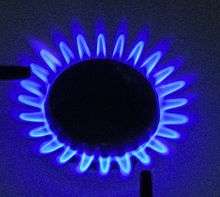Fuel gas
Fuel gas is any one of a number of fuels that under ordinary conditions are gaseous. Many fuel gases are composed of hydrocarbons (such as methane, biogas or propane), hydrogen, carbon monoxide, or mixtures thereof. Such gases are sources of potential heat energy or light energy that can be readily transmitted and distributed through pipes from the point of origin directly to the place of consumption.
.jpg)
Fuel gas is contrasted with liquid fuels and from solid fuels, though some fuel gases are liquefied for storage or transport. While their gaseous nature has advantages, avoiding the difficulty of transporting solid fuel and the dangers of spillage inherent in liquid fuels, it also has limitation. It is possible for a fuel gas to be undetected and collect in certain areas, leading to the risk of a gas explosion. For this reason, odorizers are added to most fuel gases so that they may be detected by a distinct smell.
The most common type of fuel gas in current use is natural gas.
Types
There are two broad classes of fuel gases, based not on their chemical composition, but their source and the way they are produced: those found naturally, and those manufactured from other materials.
Manufactured fuel gas
Manufactured fuel gases are those produced through an artificial process, usually gasification, at a location known as a gasworks.
Manufactured fuel gases include:
- Coal gas
- Water gas
- Producer gas
- Syngas
- Wood gas
- Uncompressed hydrogen or compressed hydrogen may be used as a fuel gas.
- Biogas
- Blast furnace gas
- Acetylene
Natural gas and petroleum gases
In the 20th century, natural gas, composed primarily of methane, became the dominant source of fuel gas, as instead of having to be manufactured in various processes, it could be extracted from deposits in the earth. Natural gas may be combined with hydrogen to form a mixture known as HCNG. There is also biogas which can be created artificially through anaerobic digestion processes.
Additional fuel gases can result as a process of refining natural gas or petroleum:
- Propane
- Butane
- Regasified liquefied petroleum gas
Uses
Fuel gases have been used in numerous applications. One of the earliest was gas lighting, which enabled the widespread adoption of streetlamps and the illumination of buildings in towns with a municipal gas supply. Fuel gas is also used in gas burners, in particular the Bunsen burner used in laboratory settings. It may also be used gas heaters, camping stoves, and even to power vehicles, they have high calorific value.
